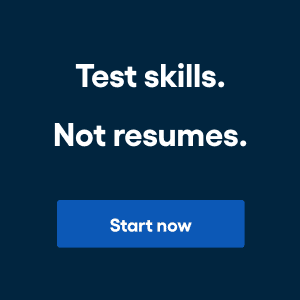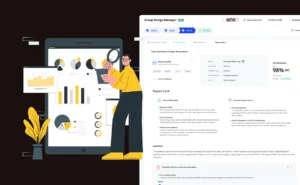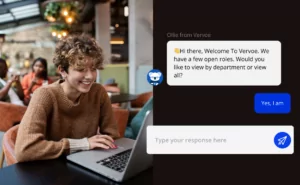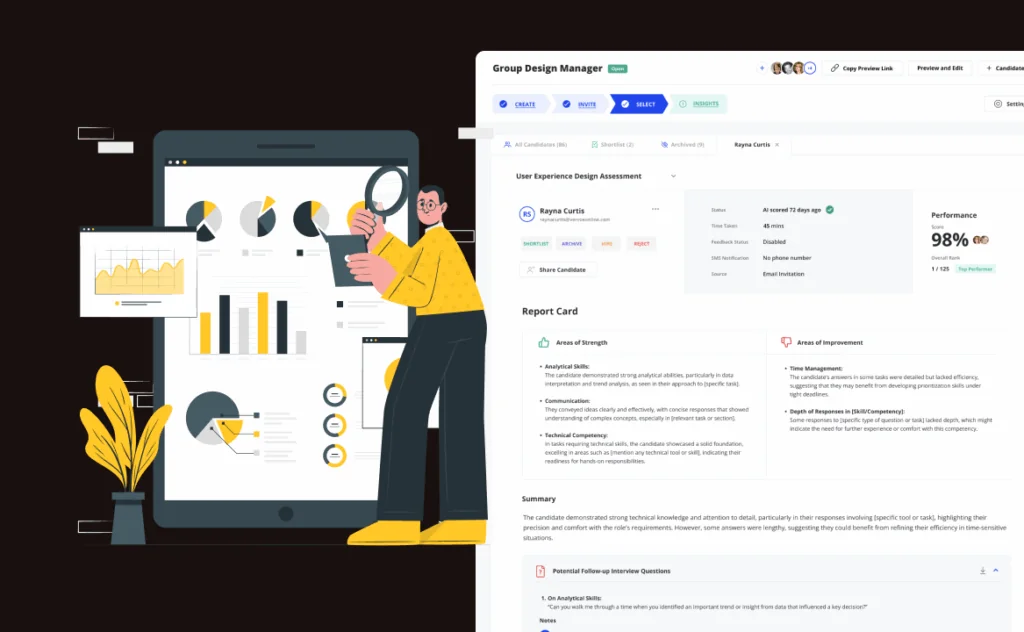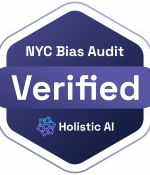Diversity hiring isn’t just the right thing to do; it’s a business imperative. Diverse teams drive innovation, improve decision-making, and outperform their more homogenous counterparts in profitability and growth. In fact, companies with diverse leadership are more likely to exceed financial targets and attract top talent.
Today, leading organizations are prioritizing diversity hiring as a way to correct systemic imbalances and unlock the full range of human potential. But doing it well takes more than good intentions. It requires a clear, data-driven strategy.
To this end, we’ll explore the key principles of diversity hiring, from building inclusive recruitment pipelines to tracking the right metrics. Whether you’re just getting started or refining your approach, these insights will help you foster a more equitable and high-performing workplace.
But first…
What is diversity hiring?
Diversity hiring is the practice of recruiting and hiring candidates based on merit, without allowing any form of bias to influence decisions. The goal is to give every qualified candidate a fair chance, regardless of their:
- Age
- Race or ethnicity
- Gender identity or expression
- Sexual orientation
- Religion
- Disability status
- Socioeconomic background
- Education or life experience
Hiring for diversity and inclusion sets out to overcome the unconscious biases, that is, the learned stereotypes that are automatic, unintentional, and deeply rooted within our beliefs. They often cause us to form an opinion about a candidate based exclusively on first impressions. Bias can creep into every stage of hiring, from writing job descriptions to screening resumes and conducting interviews.
Diversity goes beyond just race or gender. It includes differences in education, personality, communication style, physical ability, life experience, and problem-solving approaches. True diversity hiring means creating a space where all voices are valued and every candidate is assessed fairly. When companies remove bias and focus on a candidate’s potential, they build more inclusive, balanced, and high-performing teams.
Understanding what diversity hiring truly means is the first step. Next, let’s explore how it differs from inclusion.
[Read more: Generational Diversity]
What is the difference between diversity and inclusion?
The terms diversity and inclusion often appear together, but they represent distinct concepts. Diversity is the “what,” the presence of employees from a range of backgrounds, identities, and experiences. Inclusion is the “how,” the culture, policies, and everyday practices that empower those individuals to contribute and succeed.
One useful way to think about the difference is through the employee lifecycle. Diversity is often most visible during recruitment, determining who gets a seat at the table, who’s hired, and who’s promoted. Inclusion, on the other hand, comes into play after those hires are made.
It’s about what happens next. As the experts of Capterra aptly put it: “Now that you have a diverse array of employees walking through your front door, what steps do you need to take to ensure they have an equal opportunity to impact your business?”
Together, diversity and inclusion form the foundation of a sustainable, high-performing business. And, it all starts with a more intentional hiring process.
[Read more: Most Diverse Companies]
Why is diversity hiring important?

Diversity hiring is important because it directly fuels innovation, creativity, and better decision-making within organizations. When diverse companies bring together people from different backgrounds, experiences, and perspectives, they unlock a broader range of ideas and solutions to help teams make smarter decisions.
This diversity of thought enhances a company’s ability to adapt to change and also drives business growth and profitability. Here are some other reasons diversity hiring is important:
- Innovation and decision-making: Diversity hiring encourages effective decision-making since employees with varied viewpoints can identify unique solutions and make smarter, well-rounded decisions. Research shows that diverse teams make better decisions up to 87% of the time and are more likely to find new market opportunities, helping them outperform competitors.
- Team performance: Diverse teams perform better because there’s room for different ideas and insights that keep them competitive. In fact, a study shows that diverse teams outperform others by 35%, making diversity hiring a strategic advantage and not just a moral imperative.
- Employee engagement and retention: When employees feel seen, valued, and included, they are more likely to stay engaged and loyal to the company. Inclusive workplaces create a sense of belonging, which boosts morale and reduces turnover. This helps companies retain talent longer and reduce the high costs of frequent hiring and training.
- Employer brand and reputation: Diversity and inclusion enhance a company’s reputation but also significantly influence job seekers’ decisions. In fact, 76% of job seekers and employees say a diverse workforce is a critical factor when considering job offers, according to a Glassdoor survey.
Diversity and inclusion initiatives contribute to an overall better experience for your team — and your shareholders. Consider some of these metrics:
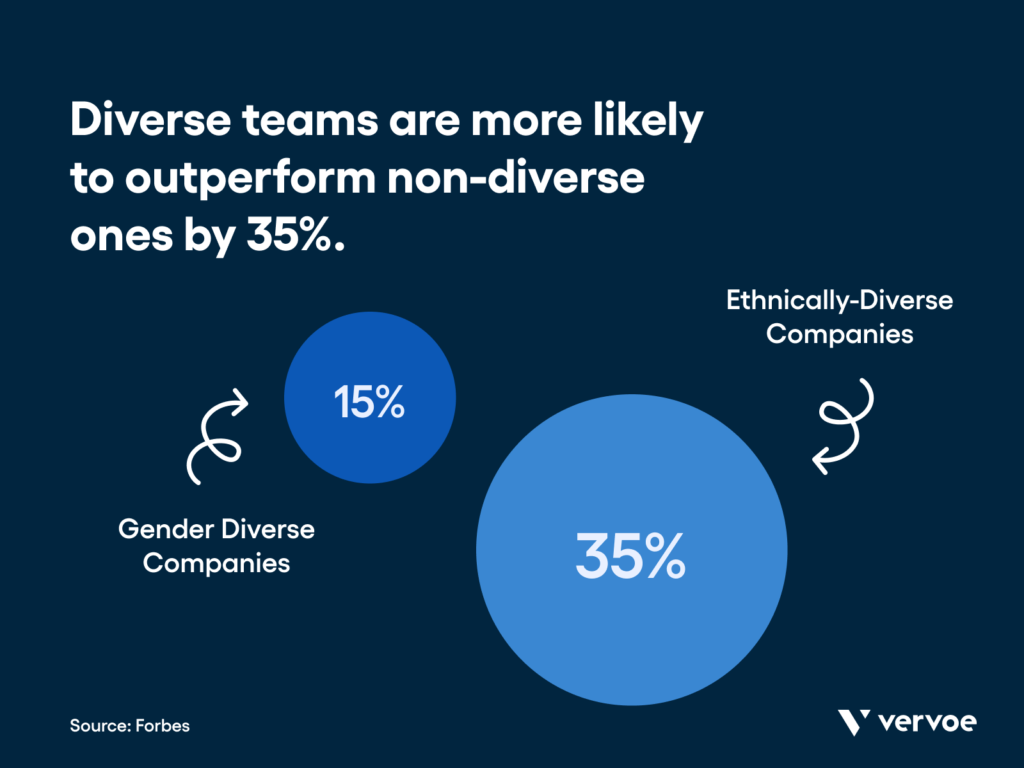
Moreover, the economic benefits of diversity aren’t limited to the workplace, but society at large. With that in mind, increasing diversity at your organization should start with a clear understanding of the legal frameworks that support the fair and equitable hiring of minorities and other underrepresented groups.
Is diversity hiring legal?
Yes, diversity hiring is completely legal when done correctly and fairly. U.S. laws such as Title VII of the Civil Rights Act of 1964, the Age Discrimination in Employment Act of 1967, and the Americans with Disabilities Act (ADA), Australia’s Equal Opportunity and Diversity protect candidates from discriminatory hiring practices based on race, gender, age, religion, disability, and other personal characteristics. In addition, the Equal Employment Opportunity Commission in the US (EEOC) and Fair Work Australia enforces these laws to ensure fair treatment and encourage inclusive hiring.
Some employers worry that hiring for diversity may lead to reverse discrimination, but the key difference lies in how decisions are made. Legal experts say it’s acceptable to choose a candidate from an underrepresented group if both candidates are equally qualified. However, selecting someone solely based on their identity, especially when they are less qualified, can cross into discriminatory territory.
Additionally, the ACLU and Australian Human Rights Commission confirms that it’s lawful to set diversity and inclusion goals, as long as they’re flexible and intended to correct historic imbalances, not rigid quotas. For example, a company might reserve spaces in a leadership development program for minority employees until its executive team better reflects the demographics of its workforce or customer base.
Diversity vs. ability: Why it’s the wrong question
Recruiters and hiring managers often hear the question: “Is diversity more important than ability?” But this sets up a false choice. In reality, diversity and ability go hand in hand, and when approached thoughtfully, one enhances the other.
According to Harvard Business Review, diversity is not just about increasing racial, national, gender, or class representation. It’s about bringing varied perspectives to the table. People from different backgrounds contribute unique approaches to problem-solving, team dynamics, communication, and leadership, which benefit organizations.
In fact, companies with above-average diversity on their management teams report higher innovation revenue, according to a Boston Consulting Group study.
Ultimately, diversity and ability aren’t competing priorities; they’re both drivers of business success.
By embracing inclusive, skills-based hiring, you move beyond surface-level assessments and tap into a deeper, more capable talent pool. The result? Teams that are not only more innovative and resilient, but also better equipped to meet the needs of a diverse world.
How to build a diversity and inclusion strategy
Creating an effective diversity and inclusion strategy takes more than good intentions. It requires structured, ongoing efforts. According to SHRM, a strong strategy should unfold in four clear phases, starting with an honest evaluation of where your organization currently stands.
1. Evaluate your current workforce
The first step in building an effective diversity and inclusion strategy is understanding where your organization currently stands. This means conducting a thorough assessment of your workforce’s demographics, both visible and invisible, to establish a baseline for improvement.
Start by checking where your team stands. Use HR records, surveys, or analytics tools to collect workforce data and set a clear baseline for your diversity goals.
Focus on protected characteristics like:
- Racial and ethnic composition: Know how your team’s racial makeup compares to the local community or industry norms.
- Gender distribution: Look at gender balance across roles and leadership to spot gaps or trends.
- Age diversity: See if your workforce includes people from multiple generations.
- Disability status: Count how many employees have disabilities and check if they’re well supported.
- Other protected characteristics: Include veteran status, religion, or sexual orientation if shared voluntarily.
Once you have this information, compare your internal data to local labor market benchmarks or industry data. This helps identify underrepresented groups and areas where your organization may be unintentionally excluding talent.
But diversity isn’t only about legal categories. Also consider nontraditional traits that shape team performance and culture. These offer deeper insight into your team’s strengths.
- Personality traits: Use tools like DISC or MBTI to learn about common personality types in your team.
- Life experiences: Look at different backgrounds or career paths and how they affect work styles.
- Communication styles: Understand who prefers collaboration versus working alone to improve teamwork.
Encourage employees to share these nontraditional traits through open-ended survey questions or anonymous suggestion boxes. You can also conduct personality tests to better understand the “invisible” aspects of your team’s diversity and tailor your inclusion efforts accordingly.
2. Identify areas for improvement
Hiring diverse talent is only the first step. It’s equally important to ensure your workplace is inclusive, respectful, and allows people to thrive. In fact, employees who feel included are 3.5 times more likely to contribute to their fullest potential, per HBR.
For this reason, you should use employee surveys, anonymous feedback tools, or focus groups to uncover blind spots in your work culture. Go beyond demographics and explore how people experience the workplace. Ask employees:
- Do you feel respected and valued?: Inclusion goes beyond just being hired to actually feeling heard and appreciated every day.
- Are your cultural or religious practices recognized?: A good way to boost a sense of belonging among employees is to acknowledge diverse holidays.
- Can you be your authentic self at work?: If employees feel they must mask their identity, it reduces psychological safety and engagement.
Small oversights, like celebrating only Christian holidays or scheduling team events during cultural observances, can unintentionally make employees feel excluded. That’s why it’s important to evaluate cultural fit versus cultural contribution. Hiring for fit can unintentionally favor sameness, while contribution encourages fresh perspectives and innovation.
Furthermore, bringing in a third-party DEI consultant can also offer an unbiased review of your internal culture. They can spot patterns and offer strategies to build more inclusive policies, messaging, and leadership behaviors to improve cultural diversity at your company.
3. Create or improve your diversity and inclusion statement
Your diversity and inclusion (D&I) statement is your company’s guiding principle for building an inclusive culture. A strong statement should clearly show:
- Your commitment to a diverse and inclusive workplace.
- Tangible goals to improve diversity, equity, and inclusion across the organization.
- How D&I influences hiring practices, employee benefits, and engagement initiatives.
Many organizations connect their D&I statement to a long-term roadmap, often using 90-day, 1-year, and 3-year goals to ensure steady and measurable progress. These milestones help track impact and hold leadership accountable.
Some examples of real actions that can support your statement include:
- Policy or benefit changes, such as updated parental leave or flexible work accommodations.
- Diversity training for managers and hiring teams to reduce bias.
- Targeted recruitment campaigns to reach underrepresented candidates.
- DEI awareness events, such as cultural celebrations or speaker series.
A well-crafted D&I statement must be backed by action and accountability. By aligning your goals with inclusive hiring practices and company-wide initiatives, you create real opportunities for diverse people to succeed. Plus, when your commitment is clear and consistent, it strengthens your work culture, customer service, and builds trust with both candidates and employees.
4. Establish long-term infrastructure
Building a strong foundation for long-term diversity and inclusion success involves creating structures that ensure accountability and continuous improvement. The U.S. Chamber of Commerce emphasizes that these efforts are key to sustaining meaningful change over time.
Here’s how you can build that infrastructure:
- Create a diversity council: Form a cross-functional team to provide leadership and oversight on D&I initiatives. This group can ensure that diversity and inclusion goals are aligned with business strategies and that progress is measured effectively.
- Appoint a diversity champion: Designate a senior leader or executive to advocate for diversity and inclusion within the organization. A diversity champion can act as a change agent and help prioritize D&I in decision-making processes at the highest levels.
- Launch employee resource groups (ERGs) or affinity groups: Encourage employees from different backgrounds to create supportive communities within your company. ERGs not only foster a sense of belonging but also contribute to initiatives around mentorship, leadership development, and community engagement.
- Implement bias training and pay parity audits: Regularly conduct training to address unconscious bias and ensure that hiring, promotions, and evaluations are equitable. Additionally, perform pay audits to identify and address any disparities in compensation across gender, race, or other demographics.
- Review diversity in leadership pipelines: Always assess how diverse your leadership teams are and make sure there is a clear path for underrepresented groups to advance within your company. One effective way to do this is by implementing mentorship and sponsorship programs that actively develop diverse talent into future leaders.
These steps will lay the groundwork for a sustainable, inclusive workplace that attracts and retains top talent from all backgrounds, ensuring long-term success for both your organization and its employees.
Note: Every company’s path to diversity will look different, but auditing your hiring practices is a strong place to start. By following these steps, you not only meet legal and ethical standards but also build a stronger, more inclusive, and higher-performing team.
5 diversity hiring practices
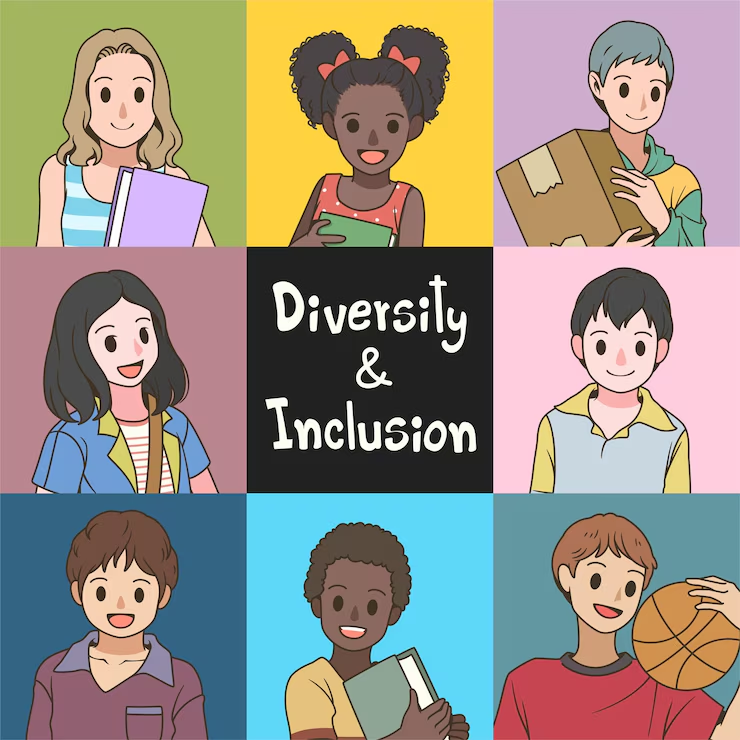
Improving workforce diversity often involves everything from employer branding to employee retention. As such, every strategy put in place must be intentional enough to offer a chance for diversity hiring in your company. However, an HBR study found that even well-meaning diversity efforts can fall short if they’re not thoughtfully planned and implemented.
To avoid common pitfalls, these five practices can help guide a more effective, inclusive hiring strategy.
1. Get commitment from leadership
Leadership is necessary when creating a lasting culture of diversity and inclusion. To build real momentum, companies must actively secure support from leadership in behavior, priorities, and accountability. This means involving executives in DEI goal-setting, tying diversity metrics to performance reviews, and having leaders visibly support inclusive initiatives. When leaders openly recognize and address unconscious bias, promote respect, and champion diverse voices, it signals that inclusion is a company-wide priority.
Strong leadership doesn’t just help attract diverse candidates; it helps retain them. A Deloitte survey found that 23% of employees have left a job in search of a more inclusive culture, spotlighting how critical leadership is in shaping the employee experience. When issues like microaggressions, bias, or exclusion are left unaddressed, they quietly erode trust, morale, and innovation potential, often driving talent out the door.
That’s why leadership commitment must go beyond policies and mission statements. It requires consistent action: calling out bias, listening to marginalized voices, and modeling inclusive behavior at every level. When leaders take real accountability for inclusion, they build a culture where everyone feels safe, seen, and empowered to thrive.
2. Revamp your candidate sourcing approach
To find diverse candidates, you must look beyond the traditional sourcing methods your company typically uses. This means sourcing candidates from places outside your careers site and LinkedIn. You can collaborate with a university or affinity organization to shape your job search while also considering these options:
- Reach out to diversity associations at universities.
- Attend diversity-focused job fairs.
- Use “terms like ‘employee resource group’ and ‘ERG’ in your Boolean search strings, along with phrases related to different types of diversity-focused networks”.
- Partner with nonprofits like the Urban League, the National Council of La Raza, or a diversity-focused job site.
Google Hiring also recommends expanding points of entry at your company by offering more paid internships, rotational programs, and contract work opportunities. By providing more opportunities and focusing on inclusivity as you hire for these new roles, you can foster a culture of diversity and grow your talent pool with intention.
Likewise, employee referrals remain one of the best ways to find and retain talent. Candidates who have been recommended by existing employees have high applicant-to-hire conversion rates and higher retention rates. So, encourage your existing employees to become team ambassadors and incentivize diverse employee referrals.
3. Check your job descriptions
Your job description can unintentionally discourage diverse candidates from applying. For example, words like “strong” and “competitive” are often perceived as masculine, while “sensitive” may deter male candidates from submitting an application.
So when writing a job description, use gender-neutral language to attract a broader pool of talented applicants. The free sourcing tool, The Gender Decoder, can help you remove biased terms from your job description.
Likewise, many companies send out job descriptions with an exhaustive list of “required” skills needed to fulfill the open role. However, listing every qualification under the sun may intimidate candidates who would be a good fit from applying. Additionally, research shows that men apply when they meet 60% of the qualifications, while women apply only if they meet 100%.
The bottom line? Only list those required skills that are most necessary to do the job in order to attract a wider range of applicants.
4. Integrate merit-based skill-testing
Instead of hiring for culture fit, which often feeds into inherent bias in recruiting, focus your process on uncovering a candidate’s capabilities. Here’s what you can do:
- Replace resume screening with an on-the-job simulation like Vervoe’s skills assessments software.
- Customize each skill test with questions and assessments that mimic the tasks required of the new hire.
This assessment style allows candidates to perform tasks relevant to the job they’ve applied for and showcase their abilities in the process.
You can also take it a step further and use an AI diversity recruiting software to screen the results of a skill test rather than having a recruiter rank candidates for the next round. A recruiter might see hundreds of resumes for a single open position.
At that volume, there’s no way one person can give each application the careful consideration it deserves. This screening process leads many recruiters to simply select candidates whose backgrounds seem most familiar or similar to theirs.
Instead, feed a merit-based, automated ranking tool data from the skills test, like Vervoe’s smart algorithm, which doesn’t eliminate candidates outright. Rather, it ranks them based on their performance, giving recruiters a clear, data-driven shortlist for the interview stage.
5. Be inclusive in your interviews
As you move from checking off qualifications to assessing real skills, it’s also important to rethink who conducts interviews. Involve multiple team members, especially those from diverse backgrounds. This is because different perspectives help create a fairer, more well-rounded hiring process.
Ask employees for feedback on job descriptions, interview questions, and other application materials. Get leadership involved to make sure employees across the board recognize the value in a diverse workplace. When managers understand the benefits of inclusive hiring, they can devote time and resources to making sure the team is fully committed to bringing on the best talent.
How do you retain diverse talent?

True talent retention is rooted in an inclusive company culture and a workplace where people of all backgrounds feel respected, valued, and empowered to succeed. And the cost of getting it wrong is staggering.
According to one study, poor workplace culture leads to over £23.6 billion in staff turnover every year in the UK alone. This goes beyond a culture problem to a critical business risk.
To retain top talent, especially from diverse backgrounds, companies must intentionally build environments where everyone can thrive. Here’s how:
- Understand your employees’ real experiences: According to HBR, “the key to inclusion is understanding who your employees really are.” So, use focus groups, one-on-one chats, and anonymous surveys to find out what underrepresented employees need to feel included and supported.
- Establish mentorship and sponsorship programs: Create mentorship opportunities that pair diverse employees with experienced leaders. Consider reverse mentoring, where senior leaders are mentored by individuals from different backgrounds to gain new perspectives.
- Ensure pay equity and transparent advancement paths: Conduct regular pay audits to uncover and fix gaps. Prioritize transparency in promotions, raises, and development opportunities to ensure everyone has a fair shot at career growth.
- Offer inclusive benefits: Go beyond the basics. Implement gender-neutral parental leave, flexible work arrangements, and mental health support. These policies show that the company cares about employees’ whole selves, not just their output.
- Train managers to be inclusive leaders: Provide training that helps managers identify barriers like imposter syndrome, unconscious bias, and microaggressions. Their behavior directly impacts whether employees feel safe and supported at work.
These practices help you create an environment where diverse employees thrive. They’ll be able to contribute meaningfully and drive innovation across the organization, allowing everyone to reap the benefits of diversity hiring.
How to measure diversity hiring
Key performance indicators are vital to understanding your progress toward improving diversity and inclusion, particularly in your hiring process. Metrics help uproot hidden biases and mindsets that promote homogeneity and hinder diverse employee retention.
Part of your diversity and inclusion strategy should involve establishing a baseline against which to measure your initiatives’ progress. Here are a few metrics to help you assess your diversity hiring:
- Representation: Compare the percentage of employees from specific identity groups to the labor market or industry benchmarks.
- Retention: Compare the average tenure of employees from specific identity groups to the average tenure across the workforce or to the average tenure of employees from the dominant group.
- Recruitment: How many applicants from target groups apply to your open positions compared to the size of the group in the overall labor market?
- Advancement: How many applicants from target groups successfully make it to each stage of the hiring process compared to all candidates?
- Selection: How many individuals from target groups are hired as compared to members from dominant groups?
- Promotion: Track the number of promotions awarded to individuals in special identity groups compared with individuals from other groups who are advanced through the organization.
Hubspot offers a worksheet designed to help you keep track of hiring metrics on a regular cadence. With metrics such as “Diversity Breakdown of Job Applicants,” your team can start to spot unconscious biases as they crop up and address them quickly.
It’s essential to remember that diversity metrics should go beyond a mere checklist. While key performance indicators can help gauge whether you’re heading in the right direction, they don’t fully capture the essence of inclusion within your organization. As one expert from Human Resources Today put it, “When used with the right intentions, metrics are useful to measure results against intentions, but they can’t measure or replace what is in your heart.”
The true value of diversity metrics emerges when they align with qualitative data, creating a more comprehensive and trustworthy picture of your progress. “When the use of quantitative data is in lockstep with the results you hope to see in qualitative data, the results of both are more valuable and trustworthy,” the expert added.
Improving your team’s diversity won’t happen overnight. But uncovering and remedying unconscious bias in your hiring process is a great place to start.
How Vervoe supports smarter, bias-free diversity hiring
As discussed above, building a truly diverse and inclusive team requires more than good intentions. It requires rethinking traditional hiring practices, from the language in your job ads to the way you evaluate talent, and that’s where Vervoe comes in.
Vervoe’s AI-powered skills assessments remove bias from the equation by letting candidates prove what they can do, not just where they’ve been. By focusing on performance over what’s on a CV, hiring teams can uncover high-potential talent from all backgrounds and create a more equitable experience for every applicant.
If you’re ready to make fair, skills-based hiring the foundation of your diversity hiring strategy, schedule a demo and see how Vervoe can help!




